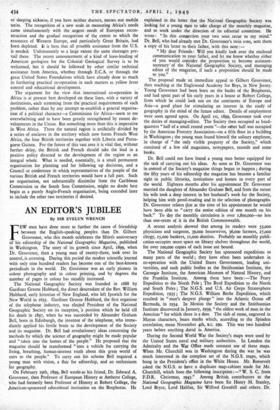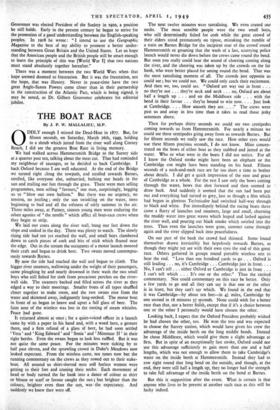AN EDITOR'S JUBILEE
By SIR EVELYN WRENCH
FEW men have done more to further the cause of friendship between the English-speaking., peoples than Dr. Gilbert Grosvenor, who this month celebrates the fiftieth anniversary of his editorship of the National Geographic Magazine, published in Washington. The story of its growth since April,. 1899, when Dr. Grosvenor, then a young man of twenty-three, took over its control, is arresting. During this period the modest scientific journal with only nine hundred readers has become one of the best-known periodicals in the world. Dr. Groivenor was an early pioneer in colour photography and in colour printing, and by degrees the number of pages in colour has steadily increased.
The National Geographic Society was founded in 1888 by Gardiner Greene Hubbard, the direct descendant of the Rev. William Hubbard, early historian of New England, who left Ipswich for the New World in 1635. Gardiner Greene Hubbard, the first organiser of the telephone industry, was elected President of the National Geographic Society on its inception; 'a position which he held till his death in 1897, when he was succeeded by Alexander Graham Bell, born in Edinburgh, the inventor of the telephone, who imme- diately applied his fertile brain to the development of the Society and its magazine. Dr. Bell had revolutionary ideas concerning the Methods by which the science of geography might be made popular and " taken into the homes of the people." He proposed that the magazine should be transformed " into a vehicle for carrying the living, breathing, human-interest truth about this great world of ours to the people." To carry out- his scheme Bell required a young man with vision, a flair for editorship, and an enthusiasm for geography.
On February 19th, 1899; Bell wrofft to his friend, Dr. Edward A. Grosvenor, then Professor of European History at Amherst College, who- had, formerly been Professor of History at Robert College, the American-sponsored educational institution on the Bosphorus. He explained in the letter that the National Geographic Society was looking for a young man to take charge of the monthly magazine, and to work under the direction of its editorial committee. He wrote : " In this conirction your two sons recur to my mind." Dr. Bell, who had already met Dr. Grosvenor's twin sons, sent them a copy of his letter to their father, with this note. :—
" My dear Friends : Will you kindly look over the enclosed communication to your father, and let me know whether either of you would consider the proposition to become assistant- secretary of the National Geographic Society, and managing editor of the matazine, if such a proposition should be made to you."
The proposal made an immediate appeal to Gilbert Grosvenor, then teaching at the Englewood Academy for Boys, in New Jersey. Young Grosvenor had been born on the banks of the I3nsphorus, and had spent part of his early years in a house at Robert College, from which he could look out on the continents of Europe and Asia—a good place for stimulating an interest in the study of geography in the mind of the future editor. Details of employment were soon agreed upon. On April 1st, 1899, Grosvenor took over the duties of managing-editor. The Society then occupied as head- quarters "half of a small rented room "—the caller half was occupied by the American Forestry Association—on a fifth floor in a building in Washington ; the young man found himself the solitary employee, in charge of "the only visible property of the Society,' which consisted of a few old magazines, new papers, records and some books.
Dr. Bell could not have found a young man better equipped for the task of carrying out his ideas. As soon as Dr. Grosvenor was in control of the Society's magazine things began to happen ; during the fifty years of his 'editorship the magazine has become a familiar sight in public libraries, institutions and homes in every part of the world. Eighteen months after his appointment Dr. Grosvenor married the daughter of Alexander Graham Bell, and from the outset his wife took a deep interest in her husband's work for the Society, helping him with proof-reading and in the selection of photographs. Dr. Grosvenor relates that at the time of his appointment he would have been able to " carry the entire edition of one month on his back." To day the monthly circulation is over ,,800,000—no less than one-tenth of it in the British Commonwealth.
A recent analysis showed that among its readers were 53,000 physicians and surgeons, 39,000 housewives, 36,000 farmers, 27,000 clergy, 15,000 bankers, 11,coo dentists. Probably no monthly publi- cation occupies more space on library shelves throughout the world, for over roo,000 copies of each issue are bound.
The National Geographic Society has sponsored expeditions to many parts of the world ; they have often been undertaken in co-operation with the United States Government, leading uni- versities, and such public bodies as the Smithsonian Institute, the Carnegie Institute, the American Museum of Natural History, and the Franklin Institute. Among them have been Peary Expedition to the North Pole ; The Byrd Expedition to the North and South Poles ; The N.G.S. and U.S. Air Corps Stratosphere
Expedition, 1935 ; The N.G.S. William Beebe Expedition, which resulted in " man's deepest plunge " into the Atlantic Ocean off Bermuda, in 1934. In' ,Mexico the Society and the Smithsonian Institute discovered in January, 1939, " the oldest work of man in the Americas " for which there is a date. The slab of stone, engraved in Mayan characters, ,bears marks which, according to the Spinden correlation, mean November 4th, B.C. 29o. This was two hundred years before anything dated in America.
During the Second World War the Society's maps were used by the United States naval and military authorities. In London the Admiralty and the Wgr Office made constant use of these maps. When Mr. Churchill was in Washington during the war he was much interested in the complete set of the N.G.S. maps, which hung in the President's office in the White House. Mr. Roosevelt asked the N.G.S. to have a duplicate map-cabinet made for Mr. Churchill, which bore the following inscription:—" W. S. C. from F.D.R. Christmas, 1943." Among British contributors to the National Geographic Magazine have been Sir. Henry M. Stanley, Lord Bryce, Lord Halifax, Sir Wilfred Grenfell and others. Dr.
Grosvenor was elected President of the Society in 192o, a position he still holds. Early in the present century he began to strive for the promotion of a good understanding between the English-speaking peoples. In 1918 he wrote: " I intend to use the Geographic Magazine to the best of my ability to promote a better under- standing. between Great Britain and the United States. Let us hope that the American people and the British people will be smart enough to learn the principle of this war [World War I] that two nations must stand absolutely together hereafter."
There was a moment between the two World Wars when that hope seemed doomed to frustration. But it was the frustration, not the hope, that was illusory. Never in peace-time have the two great Anglo-Saxon Powers come closer than in their partnership in the construction of the Atlantic Pact, which is being signed, it may be noted, as Dr. Gilbert Grosvenor celebrates his editorial jubilee.







































 Previous page
Previous page